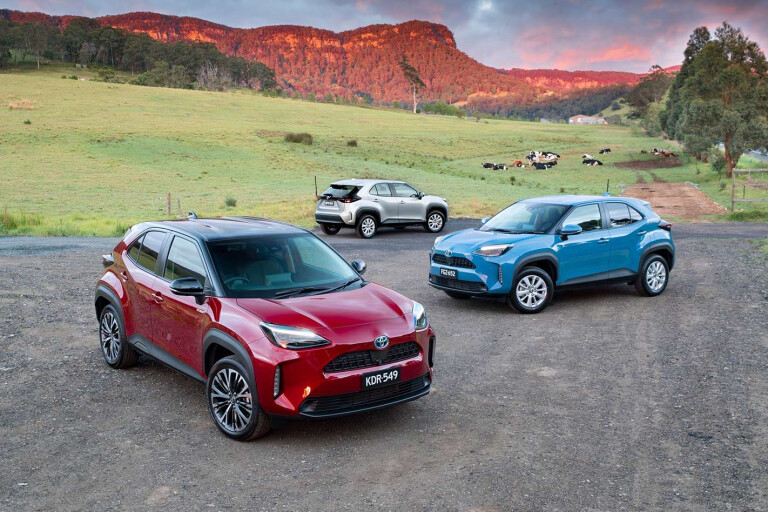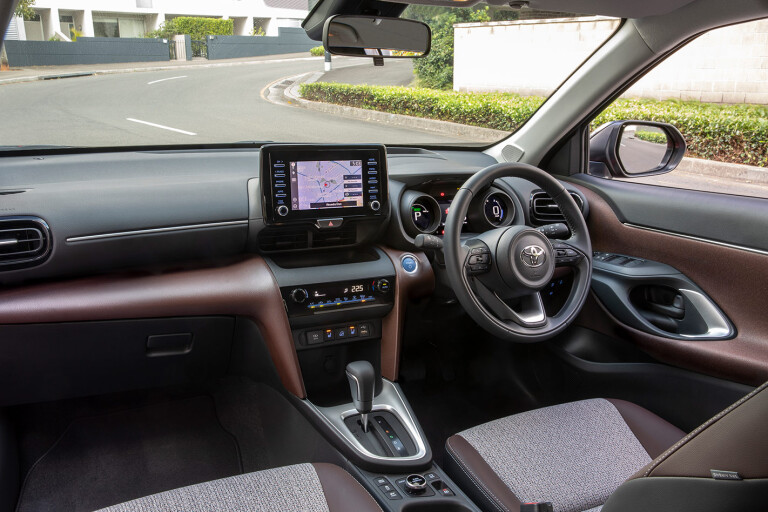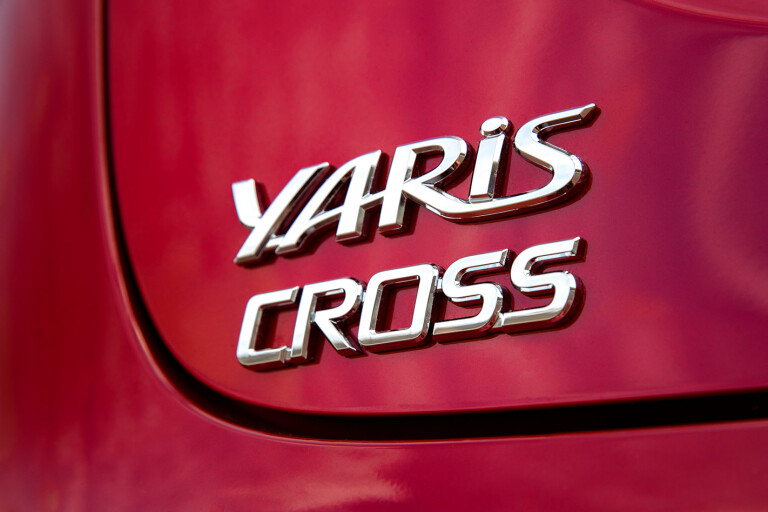
Score breakdown
Things we like
- Body control and dynamics
- Safety features and driver assistance
- Good on fuel consumption
Not so much
- Engine noise
- Zero amenity for rear passengers
- High price for hybrid AWD
There’s a heap of overlap on price, and, with nine variants available, no shortage of choice.
In fact, the price span for Yaris Cross is so broad – $26,990 (+ORC) right through to $37,990 (+ORC) it treads all over the toes of the larger C-HR, and even steps into RAV-4 territory, where the cheapest hybrid (the GX 2.5 front-driver) is actually around $1000 less expensive than the range-topping Yaris Cross Urban AWD.
All three equipment grades of the new model – GX, GXL and Urban – are available with a choice of three powertrains (all using a 10-step CVT.)
The basic FWD layout is powered by the Yaris hatch’s 1.5-litre three-pot petrol making 88kW/145Nm, while the FWD hybrid uses the same 1.5 running in Atkinson Cycle to make 67kW/120Nm, teamed with a pair of motors that produce a maximum combined output of 85kW (with combined max torque not specified.)
Opting for the AWD hybrid powertrain sees a third electric motor driving the rear wheels, engaged only in slippery or off-tarmac conditions when traction demands it.
We didn’t drive the AWD version off-road, but according to Toyota, the system is capable of sending up to 60 percent of available torque to the rear end, which, by the way, is independently sprung, as opposed to the torsion beam fitted to the FWD models.

Curiously, the addition of the extra motor on the AWD version doesn’t actually boost the overall claimed power of 85kW.
What is does boost is the price tag, by a hefty $3000 over the FWD hybrid equivalent across the three specs levels.
Given that the step up to FWD hybrid over petrol-only is just $2000 in all three trim levels, we’d question the sense of AWD for most Aussie buyers.

How big is the Yaris Cross?
Size-wise, Yaris Cross is on a platform only 10mm longer (with 35/45mm wider tracks; f-r) than that of the Yaris hatch, but with its body measuring 4180mm long, 1765mm wide and 1590mm tall, it’s 240mm longer, 70mm wider and 85mm higher than the hatch, while providing just 20mm more ground clearance.
That overall length still puts it around 200mm shorter than the current Corolla hatch, but there’s just enough room in the back for a couple of six-footers if the front occupants don’t need full rearward travel of their seats.
And despite the sloping roofline, adults have enough headroom.
For the kids who’ll be the main occupants of the back of a Yaris Cross, there’s ample room, but even in the top-spec Urban, there’s a startling lack of amenity.
There are no USB ports, no air vents, not even grab handles. It’s gob-smacking, as is the lack of body-coloured paint for the engine bay and under-bonnet.

How does the Toyota Yaris Cross drive?
As for powertrain performance and general on-road driving experience, it mostly reflects the mixed bag we experienced in the Yaris hatch.
The engine’s commendably smooth for a triple, and actually has an engaging note under load. It’s also flexible enough without the hybrid system to get the job done in undemanding urban driving.
That’s the good bit. But the moment you ask it to up the ante, whether on the open road, or just trying crack on a bit in traffic, it’s a classic atmo that demands revs to produce torque, and here, revs equal volume.
It quickly gets tediously raucous when peddled with vigour, even if consumption remains low at around 5.5L/100km in the real world.
Jumping into the hybrid, it’s blindingly clear that this is $2000 well spent.
The extra torque of the motors means the petrol engine works way less hard, and the whole show is quieter, more responsive, and way more pleasant.

We didn’t get to try the GX and GXL on their 16-inch wheels; it’s likely they’re a bit more pliant than the Urban on 18s.
Overall body control and sense of planted predictability is excellent; much like the hatch.
Safety and equipment also largely mirrors the Yaris hatch, with all models fitted with Toyota’s full suite of safety tech, including twin centre seat-mounted airbags.
Along with the aforementioned 18s, Urban brings electric adjustment for the driver’s seat and heating for both front pews, as well as a powered tailgate with kick sensor.
Toyota Yaris Cross: our pick
For our money, we could live without those extras, and would definitely take a hard pass on the $3K AWD.
That makes FWD GXL hybrid, at $31,990, the pick of the line-up. But while it may be more fashionable, fact is it’s not as mature and complete as a Corolla...

Toyota Yaris Cross rivals
Mazda CX-3, Hyundai Venue, Ford Puma, VW T-Cross, Citroën C3 Aircross
Toyota Yaris Cross specs
| Model | Toyota Yaris Cross GXL 2WD hybrid |
|---|---|
| Engine | 1.5-litre three-cylinder |
| Electric Motor | single (front axle) |
| Battery | 0.8kWh lithium ion |
| Max power | 85kW @ 5500rpm (combined) |
| Max torque | 120Nm @ 3800-4800rpm (engine only) |
| Transmission | CVT automatic |
| Weight | 1265kg |
| 0-100km/h | 10.5sec (estimated) |
| Economy | 3.8L/100km |
| Price | $31,990 |
Score breakdown
Things we like
- Body control and dynamics
- Safety features and driver assistance
- Good on fuel consumption
Not so much
- Engine noise
- Zero amenity for rear passengers
- High price for hybrid AWD

COMMENTS